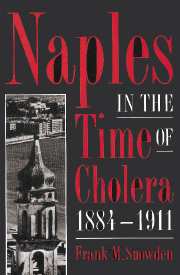Book contents
- Frontmatter
- Contents
- List of figures
- List of tables
- Preface
- Glossary of Italian and Neapolitan term
- Introduction
- PART I SANITARY ANXIETIES
- PART II THE PUBLIC EPIDEMIC OF 1884
- PART III RISANAMENTO AND MIASMA
- PART IV THE SECRET EPIDEMIC OF 1910–1911
- Conclusion: Neapolitan cholera and Italian politics
- Appendix
- Notes
- Select bibliography
- Index
Conclusion: Neapolitan cholera and Italian politics
Published online by Cambridge University Press: 04 August 2010
- Frontmatter
- Contents
- List of figures
- List of tables
- Preface
- Glossary of Italian and Neapolitan term
- Introduction
- PART I SANITARY ANXIETIES
- PART II THE PUBLIC EPIDEMIC OF 1884
- PART III RISANAMENTO AND MIASMA
- PART IV THE SECRET EPIDEMIC OF 1910–1911
- Conclusion: Neapolitan cholera and Italian politics
- Appendix
- Notes
- Select bibliography
- Index
Summary
Neapolitan experience between 1884 and 1911 vindicates Asa Briggs and Louis Chevalier in their early insight that Asiatic cholera was a major transformative experience in the societies it affected, linking the history of medicine to the broader concerns of political, social, cultural and urban history. The ravages of the city of Naples in this period constitute an ideal test case for such a perspective because they occur so late. The fifth and sixth pandemics that mark the boundaries of this study were unlike the dramatic events of the 1830s that have most attracted historians. By the time the infection broke out in the boroughs of Porto and Mercato in the summer of 1884, it was an all too familiar visitor; its aetiology was largely understood; the mortality it caused had greatly diminished; and the medical and political authorities of the day understood the preventive measures that needed to be taken to prevent further epidemics. In 1910 and 1911 cholera could even be described as a disease whose time had passed because highly effective means existed to prevent, contain and treat it.
Even in such circumstances, cholera had a major impact on the history of the city. A major reason in 1884 is what might be termed its moral chronology. Morally, the epidemic of that year was the first for which the new Liberal regime could be held responsible. United Italy had already been devastated by a major epidemic of cholera in the 1860s. At that early date, however, the overthrow of the ancien régime was too recent and the new order too precariously established for it to be held accountable for the conditions that promoted Asiatic cholera.
- Type
- Chapter
- Information
- Naples in the Time of Cholera, 1884–1911 , pp. 360 - 368Publisher: Cambridge University PressPrint publication year: 1995



